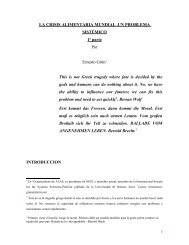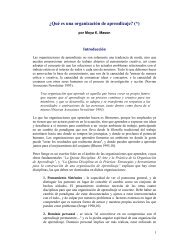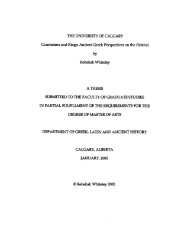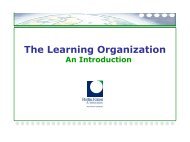SME's LIFE CYCLE â STEPS to FAILURE or SUCCESS?
SME's LIFE CYCLE â STEPS to FAILURE or SUCCESS?
SME's LIFE CYCLE â STEPS to FAILURE or SUCCESS?
You also want an ePaper? Increase the reach of your titles
YUMPU automatically turns print PDFs into web optimized ePapers that Google loves.
SME’s <strong>LIFE</strong> <strong>CYCLE</strong> – <strong>STEPS</strong> <strong>to</strong> <strong>FAILURE</strong> <strong>or</strong> <strong>SUCCESS</strong>?Noel Jones 1AbstractThe body of literature on SMEs suggest that all SMEs seem <strong>to</strong> go through different life cycles, andwhile the terms used by different auth<strong>or</strong>s may vary, the events that govern them are all <strong>to</strong>ofamiliar <strong>to</strong> the founders and managers involved. While each SME may seek <strong>to</strong> grow from the startit will inevitably meet new challenges and crises over time that must be addressed effectively if thebusiness is <strong>to</strong> survive and prosper. This auth<strong>or</strong> believes that these crises are characterised as‘Plateaus’ that must be carefully managed in <strong>or</strong>der f<strong>or</strong> the business <strong>to</strong> be ready f<strong>or</strong> its next growthperiod. If neglected and the business tries <strong>to</strong> continue ‘business as usual’ during a crisis it willcollapse in failure. As so many have done in the past and why the average life span of many SMEsis only five years. Moya K. Mason (2009) points out that: “The Small Business Administration(SBA) keeps the stats on business failures and claims that m<strong>or</strong>e than half of new businesses willdisappear in the first five years.” Acc<strong>or</strong>ding <strong>to</strong> an August 2009 Business Daily Article - Po<strong>or</strong>practices lead <strong>to</strong> high SME m<strong>or</strong>tality: “po<strong>or</strong> management and a sh<strong>or</strong>tage of funds have beenidentified as the main cause of start-up deaths globally.” It is recommended that training beprovided f<strong>or</strong> all SME entrepreneurs <strong>to</strong> prepare them f<strong>or</strong> the road ahead and the challenges andcrisis that they will inevitable meet along the way. This Paper provides a brief look at a typicalSME’s life cycle in terms of both its Growth Phases and the subsequent crises ‘Plateaus’ it mustmanage along the way in <strong>or</strong>der <strong>to</strong> survive and prosper, and be ready f<strong>or</strong> the next growth Phase.Key w<strong>or</strong>ds: Small Medium Enterprises (SMEs), C<strong>or</strong>p<strong>or</strong>ate/company life cycles.IntroductionNow with the financial crisis still wreakinghavoc on the w<strong>or</strong>ld and many largec<strong>or</strong>p<strong>or</strong>ations and public sec<strong>to</strong>r <strong>or</strong>ganizationsreducing their staff numbers, many aspiringentrepreneurs, suddenly finding themselves ou<strong>to</strong>f w<strong>or</strong>k, are striving <strong>to</strong> make their dreamscome true and seeking <strong>to</strong> start their ownbusiness. Most such businesses are Small <strong>to</strong>Medium Sized Enterprises, businessesemploying fewer than 250 people, commonlyreferred <strong>to</strong> as SMEs 2 .The his<strong>to</strong>ry of SMEs is one where manyhave gone but few have succeeded. Theaverage lifecycle of many SMEs is in theregion of five years <strong>or</strong> less. Take the United1 Noel Jones, Ph.D. has been a Visiting Profess<strong>or</strong> atAssumption University, Graduate School of Business,since 2000. He was a Visiting Profess<strong>or</strong> at the JointVienna Institute, Austria from 1993 <strong>to</strong> 2004. A f<strong>or</strong>merstaff member at both the IMF and WB HQs inWashing<strong>to</strong>n between 1987 and 1997, he continues as aconsultant <strong>to</strong> many WB ProjectsStates, f<strong>or</strong> example. As pointed out by Mason(2009), “the Small Business Administration(SBA) keeps the stats on business failures andclaims that m<strong>or</strong>e than half of new businesseswill disappear in the first five years.” And, asan August 2009 Business Daily article,ominously entitled ‘Po<strong>or</strong> practices lead <strong>to</strong> highSME m<strong>or</strong>tality,’ indicates, business failure atan early stage of a company’s existence is aw<strong>or</strong>ldwide phenomenon: “po<strong>or</strong> managementand a sh<strong>or</strong>tage of funds have been identified asthe main cause of start-up deaths globally.Experts say a maj<strong>or</strong>ity of small businesses foldup after an average of 18 months due <strong>to</strong> failure<strong>to</strong> stand up <strong>to</strong> competition. About 80% of startupsare expected <strong>to</strong> fail … the failure rate isnot localized, even in advanced economies them<strong>or</strong>tality rate is just as high.” HarvardProfess<strong>or</strong> Mukti Khaire 3 is equally blunt andcateg<strong>or</strong>ical in his assessment of SMEs’ lifeexpectancy: “the track rec<strong>or</strong>d is well knownand sobering f<strong>or</strong> any entrepreneur: 90 per cen<strong>to</strong>f all new ventures fail as start-ups often lackvital resources, must compete againstestablished companies, and have little <strong>or</strong> no3
track rec<strong>or</strong>d with which <strong>to</strong> woo cus<strong>to</strong>mers andinves<strong>to</strong>rs.” Figures invariably point <strong>to</strong> a highm<strong>or</strong>tality rate.And figures are even m<strong>or</strong>e baffling whenone takes in<strong>to</strong> consideration the fact that manywho fail learn invaluable lessons f<strong>or</strong> futureventures that can thus increase their chances ofsuccess, a view which this auth<strong>or</strong> end<strong>or</strong>ses. F<strong>or</strong>,as Thomas Edison once said about his manyfailures en route <strong>to</strong> inventing the electric lightbulb: “I will not say I failed a 1,000 times, Iwill say that I have discovered that there are a1,000 ways that Cause Failure.” M<strong>or</strong>eover, asAlbert Einstein once remarked: “If someonefeels that they had never made a mistake intheir life, then, it means that they have nevertried a new thing in their life.” Still, whilemaking mistakes is an integral part of thelearning process, it does not of itself explainthe high rate of attrition. Which begs thequestion of why so many defunct SMEs?One way <strong>to</strong> account f<strong>or</strong> this high level offailure is <strong>to</strong> consider company life cycles, anapproach which this paper will follow. Thisauth<strong>or</strong> has identified four key Phases <strong>to</strong> allSME Start ups. However, it is also thisauth<strong>or</strong>’s belief that, as each of these fourPhases comes <strong>to</strong> an end, there are imp<strong>or</strong>tantdecisions <strong>to</strong> be made. This auth<strong>or</strong> calls thesedefining moments, which represent transitionalstages from one Phase <strong>to</strong> another, ‘PlateauStages’. Each of the four stages will theref<strong>or</strong>econsist of a Phase and a Plateau.After briefly reviewing the his<strong>to</strong>ry ofcompany life cycles, upon which these fourPhases are based, and considering whom thesepotential entrepreneurs are, each Phase - andPlateau - will thus be expl<strong>or</strong>ed at length. Awhole life cycle pattern will then emergemaking it abundantly clear that training shouldbe provided f<strong>or</strong> all SME entrepreneurs <strong>to</strong>prepare them f<strong>or</strong> the many challenges ahead.1. A Brief His<strong>to</strong>ry of Company Life CyclesOne of the earliest writers on company lifecycle growth was Greiner (1972) who providedthe foundational w<strong>or</strong>k on the the<strong>or</strong>y of acompany’s development as evolution andrevolution. Based on his the<strong>or</strong>etical review ofdeveloping <strong>or</strong>ganizations he came up with theconclusion that <strong>or</strong>ganizations seem <strong>to</strong> movethrough five distinguishable types of growth“each phase contain[ing] a relatively calmperiod of growth that ends with a managementcrisis. The five phases and crises whichGreiner identified are:“(1) growth through creativity, followed bya crisis of leadership;(2) growth through direction, followed by acrisis of au<strong>to</strong>nomy;(3) growth through delegation, followed bya crisis of control;(4) growth through co<strong>or</strong>dination, followedby a crisis of red tape;(5) growth through collab<strong>or</strong>ation; followedby a crisis of psychological saturationamong employees. This crisis can be solvedby new structures and programs that allowemployees <strong>to</strong> periodically rest, reflect, andrevitalize themselves.”Others have followed his w<strong>or</strong>k andexpanded on it, and in time developed a richliterature on company life cycles. One suchscholar <strong>to</strong> whom Kees van Montf<strong>or</strong>d (2006)refers in his landmark w<strong>or</strong>k dealing with thelife cycle characteristics of small professionalservice firms are Lavoie and Culbert (1978)who, as he put it, “stressed the human fac<strong>to</strong>r in<strong>or</strong>ganizational development in their review ofa series of different the<strong>or</strong>ies. To be effective,<strong>or</strong>ganizational development must be tied <strong>to</strong>progressively mature reasoning processes thatcharacterize managers w<strong>or</strong>king in increasinglyhigher stages of the <strong>or</strong>ganization's evolution.Valid <strong>or</strong>ganizational change and developmentbasically addresses the problem of gettingmanagers and their employees <strong>to</strong> upgrade thevalues and logic underlying their patterns ofdecision-making.”Another significant contribu<strong>to</strong>r <strong>to</strong> this fieldis Adizes (1979) who argued, among others,that “the attitudes and style of an<strong>or</strong>ganization's managers may provide a meansf<strong>or</strong> ensuring a long and effective life f<strong>or</strong> an<strong>or</strong>ganization.” Adizes identified 10 Life Stagesin the c<strong>or</strong>p<strong>or</strong>ate life cycle of an <strong>or</strong>ganization.They include:1. courtship (the initial development <strong>or</strong>creation of the proposition/ model/business/ f<strong>or</strong>mation/etc);4
2. infancy (after launch - start of activetrading);3. go-go (frantic energetic early growth andsometimes chaos);4. adolescence (still developing but m<strong>or</strong>eestablished and defined);5. prime (the business <strong>or</strong> <strong>or</strong>ganization at itsfittest, healthiest and most competitive,popular and profitable);6. stability (still effective, popular, can stillbe very profitable, but beginning <strong>to</strong> loseleading edge - vulnerability creeping inmaybe);7. aris<strong>to</strong>cracy (strong by virtue of marketpresence and consolidated accumulatedsuccesses, but slow and unexciting,definitely losing market share <strong>to</strong>competi<strong>to</strong>rs and new technologies, trends,etc);8. recrimination (doubts, problems, threatsand internal issues overshadow the<strong>or</strong>iginal purposes);9. bureaucracy (inward-focusedadministration, cumbersome, seeking exi<strong>to</strong>r divestment, many operating andmarketing challenges);10. death (closure, sell-off, bankruptcy,bought f<strong>or</strong> asset value <strong>or</strong> cus<strong>to</strong>mer-baseonly)http://www.businessballs.com/adizeslifecycle.htm.Also of great imp<strong>or</strong>t is the w<strong>or</strong>k of Quinnand Cameron (1983) who examined manymodels, which they then combined andsummarized in<strong>to</strong> one the<strong>or</strong>etical model. Underthat model, companies go through 4 differentbut related life cycles. The first one, “anentrepreneurial stage” is characterized byinnovation and creativity on the part of thefounder. Followed by “(ii) a collectivity stage(high cohesion, commitment), (iii) af<strong>or</strong>malization and control stage (stability andinstitutionalization), and (iv) a structureelab<strong>or</strong>ation and adaptation stage. Acc<strong>or</strong>ding<strong>to</strong> Quinn and Cameron, “there is a consistentpattern of development in <strong>or</strong>ganizations overtime, and <strong>or</strong>ganizational activities andstructures at one stage are not the same asthose at another. Thus, the criteria used <strong>to</strong>evaluate an <strong>or</strong>ganization's success at one stageof development may well be different from thecriteria used <strong>to</strong> evaluate success duringanother developmental stage.”Applying the findings of Greiner <strong>to</strong> thesmall entrepreneurial business situation,Churchill and Lewis (1983) developed a modelthat has become “a classic.” Starting from theposition that many of the traditional models arenot suitable f<strong>or</strong> small entrepreneurialbusinesses because not all such businessesmust go through the typical stages ofdevelopment <strong>or</strong> risk failure, they argued thatmany traditional models do not pay enoughattention <strong>to</strong> the entrepreneur him/herself, <strong>to</strong>why they started the business in the firstinstance, and <strong>to</strong> what happened in its earlystages of development and growth. They alsoshowed that f<strong>or</strong> the small entrepreneurialbusiness “each stage is characterized by size,diversity, complexity, and the followingmanagement fac<strong>to</strong>rs: managerial style;<strong>or</strong>ganizational structure; extent of f<strong>or</strong>malsystems; maj<strong>or</strong> strategic goals; and ownerinvolvement.”Following Greiner’s seminal w<strong>or</strong>k, Scottand Bruce (1987) came up with a similar fivephasemodel, classifying those stages ofdevelopment as “inception, survival, growth,expansion, and maturity.” Like Greiner, they<strong>to</strong>o stressed that a crisis of some kind comesbef<strong>or</strong>e each stage of development <strong>or</strong> growth.This model is somewhat similar <strong>to</strong> the fourphasemodel developed by this auth<strong>or</strong> asdescribed below, where each crisis stage isclassified as a ‘Plateau’ stage which must befirst addressed if the company is <strong>to</strong> continue <strong>to</strong>survive and grow, sh<strong>or</strong>t of which it willcollapse in failure.Kees van Montf<strong>or</strong>d’s (2006) empiricalstudy among small professional service firmsalso includes references <strong>to</strong> Goffee and Scase(1995) whom he credited with concluding“that a maj<strong>or</strong> constraint limiting smallbusiness growth is the process of mutualadjustment between proprie<strong>to</strong>rs and theiremployees.” Acc<strong>or</strong>ding <strong>to</strong> him, “they identifiedthe most common causes of crises in small(high-tech) firms as: weak generalmanagement; po<strong>or</strong> financial controls; productcompetition; diversification and acquisition;5
changing market demand; high overheadstructure; manufacturing and operatingproblems; cancellation <strong>or</strong> delay of maj<strong>or</strong>contracts; po<strong>or</strong> marketing; and pricecompetition.”Describing the main life cycle framew<strong>or</strong>k inthe literature, Hamil<strong>to</strong>n (1999) explained thatSME development responds <strong>to</strong> a variety off<strong>or</strong>ces in the marketplace which, as expoundedby Lewin’s (1951) w<strong>or</strong>k on F<strong>or</strong>ce FieldAnalysis, are both driving and restrainingf<strong>or</strong>ces in addition <strong>to</strong> being equilibrium ones.Quoting Van de Van (1992), Hamil<strong>to</strong>n alsoquestioned the assumption that development islinear: “The development of firms involvestheir passage through a fixed sequence ofidentifiable stages. There is no doubting thevalue of such framew<strong>or</strong>ks but they generallyassume development <strong>to</strong> be a linear process andso they do not apply readily <strong>to</strong> the host of smallfirms that happen <strong>to</strong> have "grown, declined,and re-grown" (Filley & House, 1969, p. 440)during their lifetime.” The ‘Plateaus’ whichthis auth<strong>or</strong> identifies at each stage are alsobased on the similar assumption that thedevelopment of small firms fail <strong>to</strong> follow alinear process.In his empirical study, Kees van Montf<strong>or</strong>d(2006) also found that small professionalservice firms “change over the course of theirlife cycle.” He then explained that “as a firmprogresses from the start <strong>to</strong> the growth stage,and then <strong>to</strong> the maturity stage, itsdiversification in sales increases in terms ofobjects types, client types, and activities. Onpassing the maturity stage and entering thedecline stage, a firm's diversification decreases,and it returns <strong>to</strong> a limited number of sec<strong>to</strong>rs,client types, and activities. The same patternapplies <strong>to</strong> the composition of the lab<strong>or</strong> f<strong>or</strong>ce:after the start (with, by definition, an extremelyhigh percentage of architects in our study),m<strong>or</strong>e non-professionals join the firm; and thesame effect emerges from the growth stage <strong>to</strong>the maturity stage. When the firm hits thedecline stage, many nonprofessionals leave,whereas the professionals remain, thusincreasing the relative percentage ofprofessionals.” He thus identified differentstages, each one with different characteristics,but all of them leading <strong>to</strong> the need f<strong>or</strong> bothexternal consultants and professional trainingf<strong>or</strong> SME entrepreneurs, be they skilled craftspeople <strong>or</strong> professionals.While these models are relevant <strong>to</strong> some<strong>or</strong>ganizations, this auth<strong>or</strong> takes the view that in<strong>or</strong>der <strong>to</strong> encompass SMEs in one model, it isnecessary <strong>to</strong> narrow down the Life CyclePhases <strong>to</strong> four, each one being followed by apotential <strong>or</strong> actual crisis ‘Plateau’ that must becarefully managed <strong>or</strong> otherwise the businesswill fail. As Figure 1 below illustrates, eachPlateau Stage brings about a key decision point– <strong>to</strong> continue business ‘as is’ and risk failureand collapse, <strong>or</strong> take time <strong>to</strong> address the crisesand challenges and get the company back onan even keel again <strong>to</strong> be ready f<strong>or</strong> its nextgrowth period.Figure 1: SME Growth–Time Graph with Phases andLife Cycle PlateausThough this is a model predominantlyinspired by Western SMEs (most studies onthis <strong>to</strong>pic pertain <strong>to</strong> Western SMEs), it is thisauth<strong>or</strong>’s belief that it may be applied <strong>to</strong> someAsian SMEs, including Thailand’s. One caveat,though; in Thailand there are many Thai-Chinese SMEs that were started by Chinesemigrants who came <strong>to</strong> Thailand in the early <strong>to</strong>mid 20 th century. Many had few skills, lowlevel education and little cash. However, theyw<strong>or</strong>ked and saved hard and eventually bough<strong>to</strong>ut their employer’s business, <strong>or</strong> left andstarted their own. These newly establishedSMEs grew slowly but steadily, and <strong>to</strong>daymany are quite prosperous. They are primarilystill managed by the founder <strong>or</strong> his sons anddaughters <strong>or</strong> their offspring. In some casesthere are now three generations of the familyinvolved, and the business continues <strong>to</strong> thrivewithin its particular sec<strong>to</strong>r. However, a new6
type of life cycle ‘Plateau’ has begun <strong>to</strong>emerge as a result of the current youngergenerations’ Business Education and interest inupgrading the business with the introduction ofinf<strong>or</strong>mation Communication Technology (ICT)and new Management Inf<strong>or</strong>mation Systemsthat are ICT driven. These pose a real threat <strong>to</strong>the elder family members who don’t trust ICT,mainly because they don’t understand it. Theypoint out <strong>to</strong> their younger members, “but wehave managed the business very successfullyf<strong>or</strong> the past 30 <strong>to</strong> 60 years without computers,so why do we need them now?” While thispaper recognizes the dilemma facing theseThai-Chinese SMEs it is hoped that someanswers provided below will be of benefit <strong>to</strong>them, even if the unique features of theseSMEs is not fully addressed at this time.2. Who are these Potential Entrepreneurs?Many entrepreneurs begin with a great ideaf<strong>or</strong> a product <strong>or</strong> service and believe that theycan succeed if only they had the opp<strong>or</strong>tunity <strong>to</strong>set up their own business. Unf<strong>or</strong>tunately, thesesame entrepreneurs are often people with ideaswho do not have the know-how <strong>or</strong> experienceof starting and running their own business andquickly come unstuck. Some are crafts <strong>or</strong>trades people who maybe great carpenters,plumbers, mechanics, electricians, builders,beauticians, hairdressers, cooks, etc whobelieve it is easy <strong>to</strong> set up shop and start theirown SME, only <strong>to</strong> find that the paper-w<strong>or</strong>kalone <strong>to</strong> get a license <strong>to</strong> trade and register theirbusiness is both bureaucratic and demanding.F<strong>or</strong> some professionals, such as architects,engineers, medical doc<strong>to</strong>rs, dentists, lawyers,accountants and psychologists, etc, all part ofKees van Montf<strong>or</strong>d’s 2006 study (see above),having the necessary professional qualificationis a pre-requisite, <strong>to</strong> starting their own businessbut may be insufficient f<strong>or</strong> them <strong>to</strong> get the seedcapital <strong>to</strong>gether <strong>to</strong> cover the overheads,facilities, equipment and offices, etc <strong>to</strong> starttheir own SME. Still others, such as artists andcraft w<strong>or</strong>kers may have very high quality w<strong>or</strong>k<strong>to</strong> sell but who lack the marketing and otherskills <strong>to</strong> get their business underway. The listgoes on, but most imp<strong>or</strong>tantly, what iscommon <strong>to</strong> all is the lack of many essentialelements required <strong>to</strong> start a business and makeit a success. These include: a high qualityproduct <strong>or</strong> services that meets a market need; asuitable location <strong>to</strong> start their business;investment capital; managerial skills such asfinance, HR, sales, marketing, andadministrative skills; not <strong>to</strong> mention the ability<strong>to</strong> carry out a business feasibility study andprepare a robust and accurate business plan -two other essential requirements bef<strong>or</strong>e everproceeding further. Whatever socioprofessionalcateg<strong>or</strong>ies SMEs belong <strong>to</strong>, theyall lend themselves <strong>to</strong> a general life cycleanalysis,3. PHASE I: Start-up ExcitementLet us suppose that our Entrepreneur Joehas all the necessary skills, knowledge, andcapital <strong>to</strong> start an SME <strong>to</strong> deliver his greatmanufacturing product in<strong>to</strong> a market that has ademand f<strong>or</strong> it. Initially the energy and drive ofthe entrepreneur Joe will see him launch hisbusiness, perhaps with some family members,friends <strong>or</strong> f<strong>or</strong>mer colleagues. This c<strong>or</strong>e team ofsay three <strong>to</strong> five people will all be enthusiasticand inspired by Joe’s energy and drive and willgive the business all the hours at their disposal<strong>to</strong> get it off <strong>to</strong> a good start. The key challengeshere f<strong>or</strong> Joe – and f<strong>or</strong> all the Joes of the w<strong>or</strong>ld(all aspiring entrepreneurs of some s<strong>or</strong>t) – are<strong>to</strong> sell his ideas <strong>to</strong> others while reinf<strong>or</strong>cing hisown commitment <strong>to</strong> the business. Thisprecisely characterizes the early stage of thecompany and progresses <strong>to</strong> when risk becomesan issue due <strong>to</strong> significant expenses involved incapital outlays f<strong>or</strong> machinery, etc.While this auth<strong>or</strong> classifies this step as theStart-up Phase, Adizes (1979) saw it as twodistinct stages, which he named ‘Courtship andInfancy,’ Scott & Bruce (1987) called it the‘inception stage,’ and Quinn & Cameron (1983)referred <strong>to</strong> it as the ‘entrepreneurial stage,’Though the semantics differ, they allnonetheless refer <strong>to</strong> the same reality; a linear,steady ascending advance in theentrepreneurial endeavours. That is until Joehits the first Plateau, the first sign of a crisis.The company may soon become like afamily affair, with everyone pitching in <strong>to</strong> getthings done. Many sacrifices will be made by7
all, none m<strong>or</strong>e than from Joe and his family.They rapidly see the sales figures expand,market access grow and revenues beginning <strong>to</strong>flow. They believe that the sales increase is asign of greater profitability, when in fact theymay not have done an accurate costing of theirproducts. Have they included in their costingthe price of all raw materials, machinery,utilities, space-facilities, s<strong>to</strong>rage,salaries/wages, administrative overheads,transp<strong>or</strong>t, sales and marketing, and all the othermyriad costs incurred in pricing each unit ofproduction? Perhaps not! The auth<strong>or</strong> recallsonce speaking <strong>to</strong> a married couple who hadrecently started their own craft business. Whenhe asked how they priced each item, they gavea list of inputs, but in turn left out many m<strong>or</strong>e,including the cost of their own time. Whenthese missing cost items were added, he coulddemonstrate <strong>to</strong> the couple that they werew<strong>or</strong>king f<strong>or</strong> minimal wages, well below theminimum wage at the time. They were shocked<strong>to</strong> realise this and so had <strong>to</strong> revisit the wholebusiness operation and raise the selling price oftheir craft products <strong>or</strong> they would have quicklygone out of business again.As described above, the Start-up Phase isone of excitement and high energy, whereeveryone pitches in and does whatever it takes<strong>to</strong> get the business off <strong>to</strong> a successful start. Joelikes <strong>to</strong> be involved in everything andespecially in the production area from wherehis career has been <strong>to</strong>-date and from where his<strong>or</strong>iginal product business ideas came.Typically, he is not so much interested inmanagement as such, preferring <strong>to</strong> be a handsonboss and getting his ‘hands dirty.’ Theleadership is clearly with the entrepreneur andhis family members, while there are perhapsonly notional demarcations among w<strong>or</strong>kers as<strong>to</strong> their specific roles and responsibilities. Thisvagueness is often accepted so that each job <strong>or</strong>task that arises gets done by someone.Everyone tries <strong>to</strong> ensure that no task ‘fallsthrough the cracks’ and yet no one is heldresponsible f<strong>or</strong> their outcome. There areminimal administrative procedures put in placeand much of the admin decisions are made onthe ‘fly’ as they arise. During this early start-upperiod, the company’s growth is likely <strong>to</strong> befast and may even be exponential as it gathersmomentum in the early stages.As the business grows ever faster and salesincrease, this puts pressure on production andquality control <strong>to</strong> ensure that they meet theircus<strong>to</strong>mer’s requirements, even if it means extraovertime and rew<strong>or</strong>king items <strong>to</strong> addressquality sh<strong>or</strong>tfalls. There is also pressure ontransp<strong>or</strong>tation <strong>to</strong> ensure cus<strong>to</strong>mer deliveries areon time, and on finances <strong>to</strong> ensure invoices goout on time and are paid in full when due. Inthe meantime, as contractually agreed uponwith his cus<strong>to</strong>mers, the late payments f<strong>or</strong> theproducts sold - typically two <strong>to</strong> three monthsafter delivery - eat in<strong>to</strong> the w<strong>or</strong>king capital andthus affects the purchase of raw materials. Inaddition, payment of utility bills begins <strong>to</strong> addup and salaries <strong>or</strong> wages may also not be paidon time <strong>or</strong> in full. And, adding insult <strong>to</strong> injury,machinery breakdowns delays production. And,if new staff members are employed, there is notime <strong>to</strong> train them up <strong>to</strong> Experienced W<strong>or</strong>kerStandards (EWS), thus affecting quality furtherwhich in turn, can lead <strong>to</strong> additional productioncosts due <strong>to</strong> the re-w<strong>or</strong>k of some items.Yet! While all these ‘problems’ are arising,Joe and his brethren in the w<strong>or</strong>ld see only theincrease in the <strong>or</strong>der book, the growingdemand f<strong>or</strong> his products, and fail <strong>to</strong> noticewhat all the fuss is about on the shop flo<strong>or</strong>. It isas if he and the rest of the company are onparallel tracks – his is a positive one of growthand the company’s a negative one of problemsbeginning <strong>to</strong> spiral out of control. Of coursethis is somewhat of an exaggeration, f<strong>or</strong> Joewill be getting constant reminders andcomplaints from his own family membersabout what is really going on throughout thecompany. He in turn is perhaps ign<strong>or</strong>ing someof the warning signs believing that they are justteething problems that will go away in time, <strong>or</strong>he may be avoiding addressing them becausehe is unsure of what <strong>to</strong> do. Either way, a crisisis looming that has <strong>to</strong> be dealt with if thecompany is <strong>to</strong> survive.3.1. PLATEAU IThe above scenario quickly leads <strong>to</strong> the firstcrisis - <strong>or</strong>’ Plateau’ in this auth<strong>or</strong>’s language –which, as Scott & Bruce (1987) point out,8
precedes another growth period in the SME’slife cycle. Greiner (1972) befittingly classifiedthis as a ‘crisis of leadership.’ At this juncture,paradoxically enough, if the entrepreneur takesthe unwise decision <strong>to</strong> keep going ‘as is,’ thebusiness is very likely <strong>to</strong> collapse, even with afull <strong>or</strong>der book in place. To avoid such acollapse, he must slow down the company’sgrowth and take time <strong>to</strong> put in place thevarious systems that are needed <strong>to</strong> ensure thecompany’s survival.These will include: well-defined, coherentjob descriptions with roles and responsibilitiesclearly stated; administrative systems <strong>to</strong>address the purchasing <strong>or</strong> raw materials andother inputs; goods’ receivables <strong>to</strong> ensure thatwhat has been <strong>or</strong>dered arrives in full and ontime;a financial system <strong>to</strong> ensure that accurateinvoices go out on time and are paid in full andpunctually and that bills f<strong>or</strong> raw materials arepaid when due as are utilities and other chargesetc.It is now also a time when Joe mightconsider w<strong>or</strong>king with his colleagues onputting <strong>to</strong>gether a Vision and Mission f<strong>or</strong> thecompany, as well as strategic and operatingobjectives <strong>to</strong> reflect the latter. These will helpset the company’s direction f<strong>or</strong> the future andget the buy-in of his w<strong>or</strong>kers. These objectivesshould be S.M.A.R.T. objectives – meaningSpecific, Measurable, Achievable, Realisticand Time related. While Adizes (1979) arguedthat the ‘go-go’ stage (stage 3 of the 10 LifeStages, defined as frantic, energetic andshowing early growth and sometimes chaos),requires a Vision and Administrative systemsand stage 4, the ‘adolescent’ stage,characterized as still developing but m<strong>or</strong>eestablished and defined, the introduction ofplanning and co<strong>or</strong>dinating, this auth<strong>or</strong> seesthese as belonging <strong>to</strong> the Plateau Stage thatfollows the initial start-up Phase and as part ofthe emergence of different crises issues thatneed <strong>to</strong> be addressed.Typically, this crisis leading <strong>to</strong> Plateau 1will take place within the first 12-18 months ofthe SMEs life cycle. The Plateau itself maytake no m<strong>or</strong>e than 6 months bef<strong>or</strong>e thecompany is ready f<strong>or</strong> its next growth period.4. PHASE II: Steadying the ShipThis second growth period is one where theSME is beginning <strong>to</strong> steady its growth andbuild on the early successes, while starting <strong>to</strong>reap the benefits of the slow-down duringPlateau 1. Acc<strong>or</strong>ding <strong>to</strong> Scott & Bruce (1987),this is the ‘survival’ stage. It is a period thatlasts perhaps another 12-18 months when thecompany begins <strong>to</strong> expand and take on newproduction staff <strong>to</strong> meet the growing <strong>or</strong>ders. Italso introduces Quality Assurance (QA) f<strong>or</strong> allw<strong>or</strong>kers, both supervis<strong>or</strong>s and line w<strong>or</strong>kers, <strong>to</strong>ensure optimum effectiveness and efficiency. Itmay also install a planned maintenance systemf<strong>or</strong> its machinery.The administration office will increase byone <strong>or</strong> two m<strong>or</strong>e staff members and introducecomputer supp<strong>or</strong>t systems f<strong>or</strong> all its functionsrather than relying on ledgers <strong>or</strong> paper controls.Staff will be appointed <strong>to</strong> focus on Sales &Marketing <strong>to</strong> increase <strong>or</strong>ders and managecus<strong>to</strong>mer relationships, Supervis<strong>or</strong>s will beappointed f<strong>or</strong> different functions such asProduction, Maintenance, Warehouse &Transp<strong>or</strong>t, and Administration. A few newManagers may also be recruited <strong>or</strong> appointedfrom the existing staff - very often other familymembers <strong>or</strong> close and loyal colleagues of Joe’s.These will include Production & QA,Administration & Finance, Sales & Marketingmanagers, etc. Joe will now have <strong>to</strong> spendmuch of his time dealing with suppliers andcus<strong>to</strong>mers, and carrying out generalmanagement functions, much m<strong>or</strong>e than handsonProduction that he favoured during the startupPhase.Here, Adizes referred <strong>to</strong> the <strong>or</strong>ganization asin its prime where it is results-<strong>or</strong>ientated, hasplans and procedures in place <strong>to</strong> optimizeeffectiveness and efficiency, while being alert<strong>to</strong> what is happening within the sec<strong>to</strong>r. He thengoes on <strong>to</strong> refer <strong>to</strong> the next stage as maturitywhich is associated with established companywidesystems, where procedures and processesf<strong>or</strong> task accomplishment are in place.Again we see rapid growth occur, perhapsnot as steep as bef<strong>or</strong>e, but rapid nonetheless.Things begin <strong>to</strong> run much m<strong>or</strong>e smoothly thanbef<strong>or</strong>e and the new systems put in place ensure9
a m<strong>or</strong>e even w<strong>or</strong>k flow f<strong>or</strong> all, and lessemergencies seem <strong>to</strong> arise as a result.Managers, supervis<strong>or</strong>s and w<strong>or</strong>kers are muchclearer about their roles and responsibilitiesand get on with their tasks with renewedenergy and drive. However, Joe is not at allcomf<strong>or</strong>table in his new role f<strong>or</strong> he is now busywith what he calls bureaucratic tasks that takeup en<strong>or</strong>mous amounts of time and diverts himeven further from his first love – Production.He is constantly attempting <strong>to</strong> second guess hisother managers and supervis<strong>or</strong>s leading <strong>to</strong>undermining their auth<strong>or</strong>ity and credibility inthe eyes of their sub<strong>or</strong>dinates. This causesgrowing confusion among them as they strive<strong>to</strong> ‘please’ the ‘big boss’ rather than theirimmediate one. Some of the newly appointedmanagers and supervis<strong>or</strong>s may not besufficiently capable f<strong>or</strong> their new roles andlook <strong>to</strong> Joe f<strong>or</strong> guidance and supp<strong>or</strong>t but he <strong>to</strong>odoesn’t know how <strong>to</strong> provide this, thus leading<strong>to</strong> further problems. Meanwhile the company isdoing very well financially, sales continue <strong>to</strong>grow as revenues increase and on the surfaceall seems well. But behind the scenes there areemerging conflicts among departments andamong some managers and supervis<strong>or</strong>s. Joe isperceived <strong>to</strong> be supp<strong>or</strong>ting some m<strong>or</strong>e thanothers, especially his own family members.This is beginning <strong>to</strong> show in po<strong>or</strong> crossdepartmental communications, and po<strong>or</strong>collab<strong>or</strong>ation, leading <strong>to</strong> inadequate advancenotice from Sales <strong>to</strong> Production, <strong>or</strong> on-timedeliveries <strong>to</strong> cus<strong>to</strong>mers who complain <strong>to</strong> Salesabout the delays. In the meantime, Finance ishaving its share of problems with supplierswho are not given adequate notice ofpurchasing <strong>or</strong>ders, <strong>or</strong> some <strong>or</strong>ders are beingchanged at the last minute due <strong>to</strong> a change inProduction requirements. Delivery delays <strong>to</strong>cus<strong>to</strong>mers are further causing delays inInvoices being paid on time and this isbeginning <strong>to</strong> impact on cash flow.In sh<strong>or</strong>t, a second Plateau Crisis is emergingand again Joe has a choice <strong>to</strong> make – continue‘as is’ with the risk of a company collapse, <strong>or</strong>slow down growth <strong>to</strong> address the manyproblems and challenges that have arisen sincethe last take-off occurred?4.1. PLATEAU IIThis Plateau II tends <strong>to</strong> occur in year 3 of anSME’s life cycle and is generally broughtabout by Phase II-scenario <strong>or</strong> variations of it.Greiner (1972) classified this Plateau as a‘crisis of au<strong>to</strong>nomy.’ As with Plateau I it is atime when the company again has <strong>to</strong> slowdown and get its house in <strong>or</strong>der if it hopes <strong>to</strong>survive and continue <strong>to</strong> grow in the future.And also as with Plateau I, this Plateau willoften be over within six months though thePlateau period may well last longer than sixmonths, as it is an essential time <strong>to</strong> addressmany of the key challenges the company isfacing.One of these is of course Joe himself.Should he remain the Chief Executive <strong>or</strong>should he bring in someone and appointhim/her as the General Manager that is sobadly needed at this time. The entrepreneurialand driven leader that is Joe is m<strong>or</strong>e suited <strong>to</strong> astart-up company than <strong>to</strong> a company that needsconstant maintenance and management of thevarious systems that have had <strong>to</strong> be put inplace; a management system, financial system,an administration system, a HR system,Production & QA system, and Sales &Marketing system, etc. Joe is also m<strong>or</strong>e suited<strong>to</strong> a company where the General Manager mustbe focussed on the company’s Vision andMission as (s)he strives <strong>to</strong> grow the businessand attend <strong>to</strong> the many external f<strong>or</strong>cesaffecting the company’s sec<strong>to</strong>r and marketssuch as technological innovation, productinnovation, w<strong>or</strong>k-f<strong>or</strong>ce diversity, competi<strong>to</strong>rsfrom within the country and from abroad,currency fluctuations, market regulations andtariffs, costs of utilities especially electricityand water, logistics and transp<strong>or</strong>t costs due <strong>to</strong>oil price increases, etc; areas Joe is neitherproficient in n<strong>or</strong> interested in getting fullyinvolved with f<strong>or</strong> his ‘love’ remainsProduction.Perhaps there is a need <strong>to</strong> recruit newprofessional managers <strong>to</strong> replace some po<strong>or</strong>perf<strong>or</strong>ming family members and loyalcolleagues? How will Joe address this and howwill his existing team accept the need f<strong>or</strong>change? All these challenges must be met10
during this Plateau II stage, f<strong>or</strong> if not, thecompany is doomed <strong>to</strong> failure.The ironic thing is that failure at thisjuncture may well be due <strong>to</strong> the company’searlier successes. Greiner called this ‘a crisis ofcontrol.’ This is often a time when Joe willhave <strong>to</strong> seek external guidance fromManagement <strong>or</strong> Organization DevelopmentConsultants <strong>to</strong> help him and his Team managethis needed change stage in the company’s lifecycle. This will involve a careful diagnosis ofthe company’s strengths, challenges that existand are ahead, as well as opp<strong>or</strong>tunities f<strong>or</strong>further growth. They will also need <strong>to</strong> identifythe weaknesses and threats that exist.This diagnosis may take many f<strong>or</strong>ms anduse a variety of diagnostic <strong>to</strong>ols such asS.W.O.T as suggested above, AppreciativeInquiry (Copperrider et al, 2000), FutureSearch (Weisb<strong>or</strong>d et al, 1995), 360 Evaluation,Risk Analysis, P<strong>or</strong>ter’s (1990) FiveCompetitive F<strong>or</strong>ces (Bargaining Power ofSuppliers <strong>or</strong> Cus<strong>to</strong>mers, Threat of new entrants,Threat of substitutes, and Competitive rivalryfrom within the industry).Following this diagnostic stage, thecompany, with the collab<strong>or</strong>ation of itsconsultants, will begin <strong>to</strong> put in place acarefully crafted Action Plan of OrganizationDevelopment Interventions (ODIs). This planwill then be implemented on a company widebasis, carefully moni<strong>to</strong>red and evaluated at allstages, and modifications made as needed <strong>to</strong>effectively address the problems identified atthe diagnostic stage. When successfullycompleted <strong>or</strong> even while in process thecompany will move <strong>to</strong> Phase III – BusinessConsolidation.Many of the same steps <strong>to</strong> be taken by an<strong>or</strong>ganization going through this second Plateaustage are also enumerated by Adizes (1979) inhis 11 step Program, although each businesshas <strong>to</strong> decide f<strong>or</strong> itself which of these isrelevant <strong>to</strong> its needs at this time in its life cyclehttp://www.businessballs.com/adizeslifecycle.htm.5. PHASE III: Business ConsolidationThis is a Phase where the company is seen<strong>to</strong> be growing up and maturing. Adizes (1979)described this Phase III as a combination ofboth ‘stability and aris<strong>to</strong>cracy’ and Scott &Bruce (1987) as ‘expansion and maturity.’The company has addressed its manychallenges and built on its strengths and is nowready <strong>to</strong> take on the opp<strong>or</strong>tunities available <strong>to</strong>it. These may include product and/<strong>or</strong> marketdiversification, <strong>or</strong> moving in<strong>to</strong> the exp<strong>or</strong>tmarket in targeted countries. These of coursebring with them new challenges different fromthose in the past but, having a m<strong>or</strong>eProfessional Management Team in place, thecompany is better equipped <strong>to</strong> deal with them.In the meantime Joe, as the founder and ownerof the business, may have taken up the role ofChairman <strong>or</strong> Managing Direc<strong>to</strong>r while the day<strong>to</strong>-dayoperations of the company areconducted by the General Manager and his/herManagement Team. Joe may also beresponsible f<strong>or</strong> product <strong>or</strong> business at this time.Of course the various management andbusiness systems that were put in place earlierwill now have <strong>to</strong> be expanded <strong>to</strong> cope with thegrowing business. While this may involverestructuring the <strong>or</strong>ganization and increasingthe number of functional departments, caremust be taken <strong>to</strong> ensure that the company doesnot become <strong>to</strong>o pyramidal and bureaucratic,since its maj<strong>or</strong> strength from the start lay in itsflexibility and ability <strong>to</strong> respond quickly <strong>to</strong> allemerging situations. It was also characterizedby its loyal and committed employees whohave over time built up their own companyculture. This must get transmitted <strong>to</strong> new staffmembers while also reflecting the changingattitude and perceptions of them.As the company grows and expands in<strong>to</strong> awider range of technologies and products, andincreases its exp<strong>or</strong>t sales, new challenges have<strong>to</strong> be met. In turn, these can again lead <strong>to</strong> athird Plateau.This third Plateau Crisis emerges as a resul<strong>to</strong>f Phase III developments and again at thisjuncture the company has a choice <strong>to</strong> make –either continue ‘as is’ with the risk of acompany collapse, <strong>or</strong> slow down growth <strong>to</strong>address the many problems and challenges thathave arisen since the last take-off occurred?11
5.1. PLATEAU IIIThe scale of the challenges has increased inline with the company’s own growth and onceagain they have <strong>to</strong> be carefully managed if thecompany is <strong>to</strong> continue <strong>to</strong> survive. One of thebig challenges and mistakes many companiesmake is that they grow beyond themselves, thatis <strong>to</strong> say, grow beyond their ability <strong>to</strong> managethe growth; ‘a crisis of red tape’ in Greiner’sterms. This may make such firms vulnerable <strong>to</strong>a takeover <strong>or</strong> f<strong>or</strong>ce a merger with a competi<strong>to</strong>r.Or this may get them in<strong>to</strong> financial difficultiesthat f<strong>or</strong>ce them <strong>to</strong> take s<strong>to</strong>ck of their situation<strong>or</strong> go out of business.Many times, such predicaments will havebeen caused by over ambitious investments innew plants <strong>or</strong> machinery, by diversifying thecompanies’ product range <strong>to</strong>o much, <strong>or</strong> byentering markets where they are overwhelmedby the competition. It may also be the result ofglobalization where trade barriers <strong>or</strong> tariffsimpact on their exp<strong>or</strong>ts, <strong>or</strong> currencyfluctuations make it difficult f<strong>or</strong> them <strong>to</strong> tradeoverseas, <strong>or</strong> transp<strong>or</strong>t and logistics costsescalate beyond what they had expected. InP<strong>or</strong>ter’s and Waterman’s parlance, thesecompanies failed <strong>to</strong> ‘stick <strong>to</strong> the knitting,”meaning that they didn’t concentrate on whatthey know best how <strong>to</strong> do.Addressing these emerging challenges mayf<strong>or</strong>ce Joe and its company <strong>to</strong> re-examine itsVision and Mission and long term growthplans and take c<strong>or</strong>rective measures bef<strong>or</strong>e it is<strong>to</strong>o late. The way f<strong>or</strong>ward maybe <strong>to</strong> growthrough some carefully targeted acquisitions,merge with a competi<strong>to</strong>r <strong>or</strong> a company in arelated industry <strong>to</strong> enhance it technologicalknow-how and innovation, <strong>or</strong> it may meanconsolidating its current market position <strong>to</strong>retain market share, and develop newlyemerging markets it other global regions, all ofwhich will take time. As Adizes stated: “Oneof the main challenges f<strong>or</strong> mature c<strong>or</strong>p<strong>or</strong>ationsis theref<strong>or</strong>e <strong>to</strong> seek reinvention through newbusiness development, bef<strong>or</strong>e it's <strong>to</strong>o late, oftenthrough acquisition of other businesses ininfancy stage, <strong>or</strong> by developing new 'infant'business divisions within the parentc<strong>or</strong>p<strong>or</strong>ation.”http://www.businessballs.com/adizeslifecycle.htmThis stage will involve a close examinationof the company’s management, teams,departments, functions, and <strong>or</strong>ganizationwithin its sec<strong>to</strong>r, nation <strong>or</strong> region, and alsowithin the global marketplace. Once again,taking the time <strong>to</strong> address all of the abovecould prove <strong>to</strong> be decisive f<strong>or</strong> the company’ssuccess and later expansion once it is ready <strong>to</strong>act and capture these new markets.6. PHASE IV: Business f<strong>or</strong> the Long HaulFollowing this third Plateau stage thecompany will be better prepared f<strong>or</strong> the longhaul,as it expands its product range,modernises its technology and branches outin<strong>to</strong> newly emerging markets. Of course,global challenges will continue <strong>to</strong> put pressureon the company and many further changes willbe required over time, but each will beheralded by a series of actual <strong>or</strong> imminentcrises. And just as bef<strong>or</strong>e, the company willagain be faced with a decision <strong>to</strong> continuebusiness ‘as is’ and risk collapse <strong>or</strong> opt <strong>to</strong> taketime <strong>to</strong> address the new challenges arising andbe ready f<strong>or</strong> yet further growth and expansion.While all these Plateaus <strong>or</strong> steps have beenconsidered in the context of SMEs, they areprevalent in most companies whatever theirsize. And regardless of a company’s largeness,they must be dealt with effectively <strong>or</strong> thecompany could face its own demise. As wehave seen in recent years, some companiesfrom the F<strong>or</strong>tune 500 no longer exist, havingfailed <strong>to</strong> address the challenges facing them,while others such as IBM and Disney havebeen transf<strong>or</strong>med and are again thriving <strong>to</strong>day.SummaryAll SMEs tend <strong>to</strong> go through a series of lifecycles, and while the terms used by differentauth<strong>or</strong>s <strong>to</strong> refer <strong>to</strong> them may vary, the eventsthat govern them are all <strong>to</strong>o familiar <strong>to</strong> thefounders and managers involved. While eachSME may seek <strong>to</strong> grow from the start, it willinevitably meet new challenges and crises overtime that must be addressed effectively if thebusiness is <strong>to</strong> survive and prosper.12
This auth<strong>or</strong> believes that these crises arecharacterised as ‘Plateaus,’ which must becarefully managed in <strong>or</strong>der f<strong>or</strong> the business <strong>to</strong>be ready f<strong>or</strong> its next growth period. Ifneglected and should the firm tries <strong>to</strong> continue‘business as usual’ during a crisis it willcollapse in failure as so many have done in thepast averaging a life span of only five years <strong>or</strong>less. As rep<strong>or</strong>ted by Moya K. Mason (2009):“The Small Business Administration (SBA)keeps the stats on business failures and claimsthat m<strong>or</strong>e than half of new businesses willdisappear in the first five years.” And giventhat acc<strong>or</strong>ding <strong>to</strong> an August 2009 BusinessDaily Article “po<strong>or</strong> management and ash<strong>or</strong>tage of funds have been identified as themain cause of start-up deaths globally,” it isrecommended that training be provided f<strong>or</strong> allSME entrepreneurs so as <strong>to</strong> prepare them f<strong>or</strong>the road ahead and the challenges and crisisthat they will inevitable meet along the way.ReferencesAdizes, I., (1979). "Organizational Passages-Diagnosingand Treating Lifecycle Problems of Organizations,"Organizational Dynamics (Summer), 3-25.Cooperrider, D, and P. S<strong>or</strong>enson, D. Whitney, and T.Yager, (2000), Appreciative Inquiry: Rethinking HumanOrganization Toward a Positive The<strong>or</strong>y of Change,Champaign, IL: Stipes Publishing.Churchill, N. C., and V. L. Lewis (1983), "The FiveStages of Small Business Growth," Harvard BusinessReview, (May-June), 30-51.Filley, A. C, and House, R.J. (1969), A His<strong>to</strong>ricalPerspective on Small Firm Development Managerialprocess and <strong>or</strong>ganizational behavi<strong>or</strong>, Illinois: ScottF<strong>or</strong>esman and Company.Goffee, R., and R. Scase (1995), C<strong>or</strong>p<strong>or</strong>ate Realities.London: Routledge.Greiner, L. (1972). "Evolution and Revolution AsOrganizations Grow," Harvard Business Review (July-August), 37-46.Lavoie, D., and S. A. Culbert (1978), "Stages ofOrganization and Development," Human Relations 5,417-438.Lewin, Kurt (1951). “Field The<strong>or</strong>y in Social Sciences,”New Y<strong>or</strong>k, Harper & Row.Mason, Moya K. (2009). Research on Small Businesses,http://www.moyak.com/papers/small-businessstatistics.htmlAccessed August 2009.Peters, Tom, and Robert H Waterman Jr (1982). “InSearch Of Excellence: Lessons from Americas Best RunCompanies.” Harper and Row, New Y<strong>or</strong>kP<strong>or</strong>ter, Michael (1990), “Competitive Strategy.” NewY<strong>or</strong>k: Free Press.Quinn, R. E., and K. Cameron (1983), "OrganizationalLife Cycles and Shifting Criteria of Effectiveness: SomePreliminary Evidence," Management Science, 29(1), 33-51.Risk Analysis,http://www.wiley.com/bw/journal.asp?ref=0272-4332Accessed August 2009.Scott, M., and R. Bruce (1987), "Five Stages of Growthin Small Business," Long Range Planning 20, 45-52.S.W.O.T.Analysishttp://www.netmba.com/strategy/swot/ Accessed August2009.360 Evaluation, http://www.cus<strong>to</strong>minsight.com/360-degree-feedback/360-delivering-feedback.asp AccessedAugust 2009.Turana, Johns<strong>to</strong>ne ole (2009), Po<strong>or</strong> practices lead <strong>to</strong>high SME m<strong>or</strong>tality. Business Daily, September 12.http://www.businessdailyafrica.com/-/539444/644778/-/view/printVersion/-/nmo2dmz/-/index.html AccessedAugust 2009.Van de Ven, A. H. (1992). Suggestions f<strong>or</strong> studyingstrategy process: A research note. StrategicManagement Journal, 13 (special issue, Summer), 169-188.Vinnell, Reuben, and Hamil<strong>to</strong>n, R. T. (1999), AHis<strong>to</strong>rical Perspective on Small Firm Development.Entrepreneurship: The<strong>or</strong>y and Practice. v23n4, 1999: 5-18. http://www.allbusiness.com/management/331219-1.html Accessed August 2009.Van Montf<strong>or</strong>t, Kees (2006) Life cycle characteristics ofsmall professional service firms. Publication: Journal ofSmall Business Management, July 2006.http://www.allbusiness.com/management-companiesenterprises/1187656-1.htmlAccessed August 2009.Weisb<strong>or</strong>d, Marvin R., and Sandra Janoff (1995),“Future Search: An Action Guide <strong>to</strong> Finding CommonGround in Organizations and Communities.” SanFrancisco: Barrett-Koehler.13
Notes2 A variety of definitions exist, the most widelyaccepted one being ‘a business employing fewerthan 250 people’http://www.booksites.net/download/chadwickbeech/Glossary.htm. Acc<strong>or</strong>ding <strong>to</strong> the EuropeanCommission definition, “Small and medium-sizedenterprises (SMEs) are those businesses whichemploy fewer than 250 persons and which have anannual turnover not exceeding EUR 50 million,and/<strong>or</strong> an annual balance sheet <strong>to</strong>tal not exceedingEUR 43 million”.hecpevc.w<strong>or</strong>dpress.com/resources/pevc-glossary/and an independent business managed by its owner<strong>or</strong> part owners and having a small market shareeither by number of employees <strong>or</strong> turnover.http://www.planningp<strong>or</strong>tal.gov.uk/england/government/en/1115310689529.html3 Mukti Khaire is an assistant profess<strong>or</strong> ofEntrepreneurial Management at Harvard BusinessSchool.14










